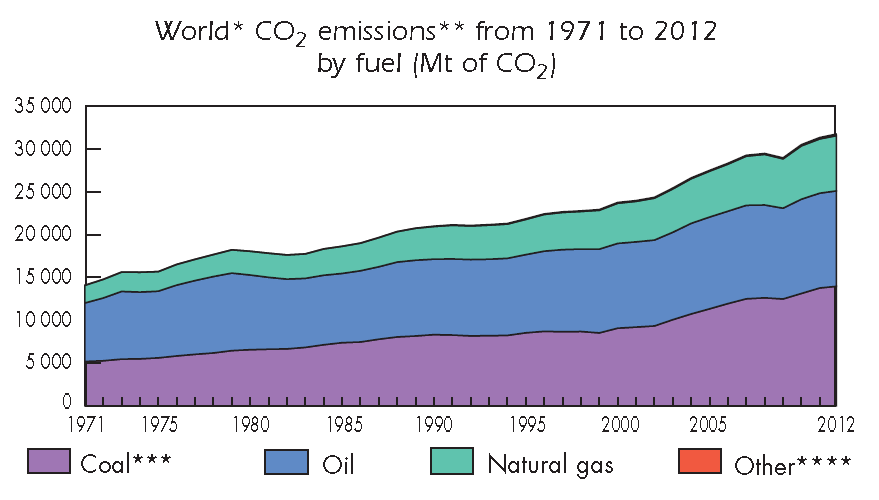IEA estimate: No reduction of global CO2 Emissions in 2014

2015
Preliminary data from the ‘International Energy Agency (IEA)‘ suggest no reduction of global CO2 Emissions from fossil fuels in 2014 compared to 2013. Global emissions were 31.7 Billion tons in 2012 and 32.3 Billion tons in 2013 as well as in 2014 (preliminary estimate). The diagram below copied from ‘IEA Key World Energy Statistics 2014’ show the global emissions from 1971 to 2012. According to IEA 2014 was the first year in four decades with growing global economy (by 3%) without a corresponding increase of CO2 Emissions from fossil fuels. Or as IEA puts it: “for the first time, greenhouse gas emissions are decoupling from economic growth.” Since the world population is growing around 1% annually the CO2 Emissions per capita has decreased by about 1% in 2014 compared to 2013 (preliminary estimate). This good news must, however, be put into perspective before applause breaks out – read below the diagram.
First five highlights to remember from ‘Early history of global warming science and predictions’:
- Back in 1896 the physicist and chemist Svante Arrhenius estimated that a doubling of CO2 in the atmosphere would cause a global temperature rise of 5–6°C … in 1906 he adjusted the value to 1.6°C. More than a century later 2014-estimates from IPCC say this value is likely to be between 1.5 and 4.5°C.
- In the 1950s the physicist and climatologist Mikhail Ivanovich Budyko expressed worries about how feedback loops of mutually reinforcing effects might amplify human influences on the global climate. In 1961, he published a warning that the exponential growth of humanity’s use of energy would inevitably heat the planet. The next year he made calculations of the Earth’s energy budget and his equations suggested that climate changes could be extreme. He also predicted that the Arctic icepack might disappear.
- In 1961 the scientist Charles David Keeling produced data showing that carbon dioxide levels were rising steadily. His ongoing research showed that the atmospheric concentration of carbon dioxide grew from 315 ppm in 1958 to 380 ppm in 2005, in correlation with increased fossil fuel emissions.
- In 1965 in the United States in a report to the White House called “Restoring the Quality of Our Environment” this prediction was made: “Carbon dioxide is being added to the earth’s atmosphere by the burning of coal, oil, and natural gas at the rate of 6 billion tons a year. By the year 2000 there will be about 25 percent more carbon dioxide in our atmosphere than at present.” The 25 percent increase of carbon dioxide in the atmosphere was reached in 2014.
- In 1979 the National Academy of Sciences in the United States released the Charney Report with this conclusion: “When it is assumed that the CO2 content in the atmosphere is doubled and statistical thermal equilibrium is achieved, the more realistic of the modeling effects predict at global surface warming of between 2ºC and 3.5ºC, with greater increases at high latitudes.”
Since then, scientific warnings have come in a steady flow along with endless climate negotiations. The world’s two largest economies China and the United States combined were responsible of 34% of the global CO2 Emissions from fossil fuels in 1980 and 41% in 2012 (and their total share of the global Climate Debt in ClimatePositions was 37% in 2013).
Despite the long history of alarming predictions China and especially the United States have persistently derailed negotiations towards a globally binding CO2 reduction agreement – and today voluntariness is still the keystone.
The stalled global Carbon Dioxide from fossil fuels in 2014 is good news, but it is also disastrous because no less than significant reductions will do. See the ‘polynomial projections of global warming‘. Note that CO2 emitted in 2012 will cause global warming the next century – with accelerating consequences due to feedback loops.
.
Preliminary data from the ‘International Energy Agency (IEA)‘
Drawing by Claus Andersen, 2015.
Comments are closed.
